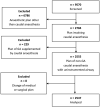Ultrasound-guided caudal blockade and sedation for paediatric surgery: a retrospective cohort study
- PMID: 35460068
- PMCID: PMC9322320
- DOI: 10.1111/anae.15738
Ultrasound-guided caudal blockade and sedation for paediatric surgery: a retrospective cohort study
Abstract
Data on safety and success rates of ultrasound-guided caudal blockade, performed on sedated children with an uninstrumented airway, are scarce. We performed a retrospective observational study of validated data from April 2014 to December 2020 in a paediatric cohort where the initial plan for anaesthetic management was sedation and caudal epidural without general anaesthesia or airway instrumentation. We examined success rates of this approach and rates of block failure and block-related complications. In total, 2547 patients ≤ 15 years of chronological age met inclusion criteria. Among the 2547 cases, including 453 (17.8%) former preterm patients, caudal-plus-sedation success rate was 95.1%. The primary anaesthesia plan was abandoned for general anaesthesia in 124 cases. Pain-related block failure in 83 (3.2%) was the most common cause for conversion. Complications included 39 respiratory events and 9 accidental spinal anaesthetics. Higher odds of pain-related block failure were associated with higher body weight (adjusted OR 1.063, 95%CI 1.035-1.092, p < 0.001) as well as with mid-abdominal surgery (e.g. umbilical hernia repair) (adjusted OR 15.11, 95%CI 7.69-29.7, p < 0.001), whereas extreme (< 28 weeks) former prematurity, regardless of chronological age, was associated with higher odds (adjusted OR 3.62, 95%CI 1.38-9.5, p = 0.009) for respiratory problems. Ultrasound-guided caudal epidural, performed under sedation with an uninstrumented airway, is an effective technique in the daily clinical routine. Higher body weight and mid-abdominal surgical procedures are risk factors for pain-related block failure. Patients who, regardless of chronological age, had been born as extreme preterm babies are at the highest risk for respiratory events.
Keywords: anaesthesia; caudal; epidural; infant; paediatrics.
© 2022 The Authors. Anaesthesia published by John Wiley & Sons Ltd on behalf of Association of Anaesthetists.
Figures




Similar articles
-
Sex differences in pediatric caudal epidural anesthesia under sedation without primary airway instrumentation.PLoS One. 2023 Jul 13;18(7):e0288431. doi: 10.1371/journal.pone.0288431. eCollection 2023. PLoS One. 2023. PMID: 37440538 Free PMC article.
-
Caudal epidural blocks in paediatric patients: a review and practical considerations.Br J Anaesth. 2019 Apr;122(4):509-517. doi: 10.1016/j.bja.2018.11.030. Epub 2019 Feb 1. Br J Anaesth. 2019. PMID: 30857607 Free PMC article. Review.
-
Management of hypertrophic pylorus stenosis with ultrasound guided single shot epidural anaesthesia--a retrospective analysis of 20 cases.Paediatr Anaesth. 2011 Feb;21(2):110-5. doi: 10.1111/j.1460-9592.2010.03452.x. Epub 2010 Nov 23. Paediatr Anaesth. 2011. PMID: 21091828
-
A prospective observational study on the feasibility of subumbilical laparoscopic procedures under epidural anesthesia in sedated spontaneously breathing infants with a natural airway.Paediatr Anaesth. 2022 Jan;32(1):49-55. doi: 10.1111/pan.14302. Epub 2021 Oct 8. Paediatr Anaesth. 2022. PMID: 34582607 Free PMC article.
-
Is ultrasound guidance mandatory when performing paediatric regional anaesthesia?Curr Opin Anaesthesiol. 2010 Jun;23(3):337-41. doi: 10.1097/ACO.0b013e328339276f. Curr Opin Anaesthesiol. 2010. PMID: 20404721 Review.
Cited by
-
Ad-hoc preoperative management and respiratory events in pediatric anesthesia during the first COVID-19 lockdown-an observational cohort study.PLoS One. 2022 Aug 18;17(8):e0273353. doi: 10.1371/journal.pone.0273353. eCollection 2022. PLoS One. 2022. PMID: 35980945 Free PMC article.
-
Ultrasound-Guided Dorsal Penile Nerve Block in Children: An Anatomical-Based Observational Study of a New Anesthesia Technique.Children (Basel). 2023 Dec 29;11(1):50. doi: 10.3390/children11010050. Children (Basel). 2023. PMID: 38255363 Free PMC article.
-
Sex differences in pediatric caudal epidural anesthesia under sedation without primary airway instrumentation.PLoS One. 2023 Jul 13;18(7):e0288431. doi: 10.1371/journal.pone.0288431. eCollection 2023. PLoS One. 2023. PMID: 37440538 Free PMC article.
-
Perioperative management of infant inguinal hernia surgery; a review of the recent literature.Paediatr Anaesth. 2023 Oct;33(10):793-799. doi: 10.1111/pan.14726. Epub 2023 Jul 14. Paediatr Anaesth. 2023. PMID: 37449338 Free PMC article. Review.
-
Pediatric Regional Anesthesia: A Practical Guideline for Daily Clinical Practice.Anesthesiology. 2025 Aug 1;143(2):444-461. doi: 10.1097/ALN.0000000000005554. Epub 2025 Jun 17. Anesthesiology. 2025. PMID: 40526440 Free PMC article. Review.
References
-
- Veyckemans F, Van Obbergh LJ, Gouverneur JM. Lessons from 1100 pediatric caudal blocks in a teaching hospital. Regional Anesthesia 1992; 17: 119–25. - PubMed
-
- Suresh S, Long J, Birmingham PK, De Oliveira GS Jr. Are caudal blocks for pain control safe in children? An analysis of 18,650 caudal blocks from the pediatric regional anesthesia network (PRAN) database. Anesthesia and Analgesia 2015; 120: 151–6. - PubMed
-
- Marhofer P, Lönnqvist PA. The use of ultrasound‐guided regional anaesthetic techniques in neonates and young infants. Acta Anaesthesiologica Scandinavica 2014; 58: 1049–60. - PubMed
Publication types
MeSH terms
LinkOut - more resources
Full Text Sources
Miscellaneous

